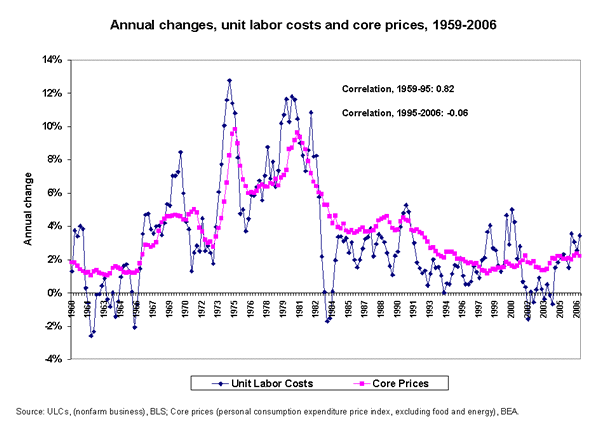See Snapshots archive.
Snapshot for March 7, 2007.
Inflation and unit labor costs: A phantom menace?
Recent reports of rising labor costs have sparked inflationary concerns. Unit labor costs (ULCs), a closely watched index of compensation, rose at a fast annual rate of over 6% in the fourth quarter of last year.1 This spike in compensation has some analysts worried that employers might pass these higher labor costs forward into prices, leading to faster inflation and possibly prompting the Federal Reserve to raise interest rates.
Yet, how likely is that scenario? In fact, while ULCs have historically tracked inflation fairly closely, this relationship has largely broken down over the past decade. The figure plots annual growth rates in ULCs and core inflation (price growth with volatile food and energy prices removed).2 The series roughly track each other; the correlation coefficient—a measure of their association that ranges between -1 and +1—is 0.81 over the whole series, a fairly high correlation. But since 1995, the correlation is -0.06, meaning more recent movements in the series are essentially unrelated.

There are plausible reasons for this breakdown, including the long-term weakening of the relationship between wage and price growth (see this recent testimony on this point), the fact that ULCs have recently been driven up by high-end compensation components (like bonuses and exercised stock options) that firms are less likely to pass through to prices,3 and the fact that inflationary expectations (the path that most people expect inflation to follow) have been less moved by swings in compensation. But whatever the cause, it is a mistake to assume a straightforward correlation between these series. They have been moving quite independently for over a decade.
Notes
1. ULCs measure nominal compensation growth relative to that of productivity. Thus, they are an indicator of the labor costs of a unit of output.
2. ULCs are from the BLS nonfarm business sector, and inflation is the core personal consumption deflator.
3. See Goldman Sachs, U.S. Daily: Labor Cost Data to Look Less Inflation Friendly, March 5, 2007.
